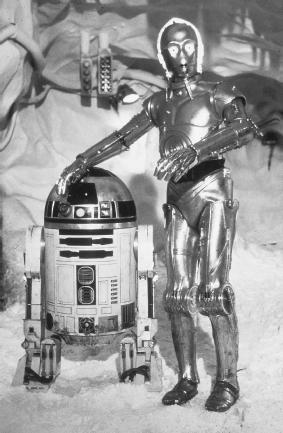Introduction
Fact Follows Fiction
As far back as the ancient Greek civilization, people have imagined machines and mechanical men that could work and think like any human. One Greek myth, for example, tells of the Greek god Hephaestus, who built mechanical men to forge powerful weapons and spectacular jewelry. When the king of Crete requested that he make a giant man to guard his island, Hephaestus constructed the metallic warrior Talos. Talos patrolled the shores of Crete until Jason and the Argonauts defeated it.
In the late 1800s, as the genre of science fiction developed, books about intelligent machines serving human masters sparked the public's imagination, but not until the 1920s did such machines acquire the name robot . In 1920 Czech playwright Karel Capek published the play R.U.R. (Rossum's Universal Robots) in which the character Professor Rossum manufactures artificial men to do all the menial chores, called robota in the Czech language. Rossum's plan backfires and armies of robots are purchased by warring nations. Eventually the robots themselves revolt and attempt to take over all of humankind.
In the 1950s and 1960s a series of movies and books portrayed the blessings but more often the horrors of intelligent machines, which took all forms. Some were Talos-like robots made of shiny metal, like Gort in The Day the Earth Stood Still (1951); others were intelligent supercomputers that threatened to take over the world in movies like Colossus: The Forbin Project (1969). In this film the supercomputer that ran the U.S. national defense systems overrode all human control. But perhaps the most famous malevolent supercomputer was HAL 9000, the sinister manager of the spaceship Discovery in 2001: A Space Odyssey (1968). HAL could learn and act independent of human input and in so doing it killed all but one crew member.

Not all robots or supercomputers have been portrayed as evil. In the 1970s moviegoers fell in love with the flighty C-3PO and quirky trashcan-shaped R2-D2 in the Star Wars series. Without the help of these autonomous beings, the heroes would not have prevailed over the evil empire. And in 2001 audiences connected with the boy robot in Steven Spielberg's film AI when he expresses emotions and feelings of love toward his adoptive human parents.
These fictional stories reflect humans' dreams and fears about intelligent machines. And there is an odd correlation between science fiction and science fact. Writers have envisioned worlds that are technologically several steps ahead of reality. They imagined robots on Mars long before the first moon landing and portable minicomputers long before the invention of laptops.
Scientists who work in the field of artificial intelligence (AI), the study of intelligent machines, also foresee a future filled with independent, thinking robots and computer companions. Unlike fiction writers, however, they face the daunting challenge of making their dreams a reality. Each year AI researchers come closer to realizing their dreams with new developments in computer programming and robotic engineering.
Real-life AI
As in fictional stories, the pursuit of intelligent machines has taken two forms. Researchers have created robotic bodies—like that of C-3PO—that look and move like a human. They have even created artificial material similar to human skin that will mask the computer chips and wiring inside a robot's head. Other researchers are working on robots that learn from experience—like those in Isaac Asimov's classic story I, Robot —and can express emotions like the robotic boy in director Steven Spielberg's feature film AI .
The second form of intelligent machines is the all-knowing and all-powerful "beings without bodies" like HAL. Artificial intelligence experts have already created supercomputers that navigate and control the space shuttles; other computer systems are powerful enough to effectively run major companies. But AI is not just reserved for grand space exploration or high finance. In fact, much of a person's daily life is affected by some form of artificial intelligence. AI computer programs keep track of a person's banking, translate foreign languages, locate a car's position, and put once hard-to-find information at a person's fingertips with the Internet. Each year smart machines become more proficient at chores we used to do for ourselves, and people purchase the newest electronic AI gadgets in hopes of making their lives easier. But what happens to a society that gives more and more control to machines? Will fact follow fiction? Will people enjoy a life of friendly companionship with robots like R2-D2 and live blissfully by relying on all-knowing machines to help them get through their days?
Anyone who has been beaten by a computer at a game of chess knows the unsettling feeling of dealing with an intelligent system. Will that unease grow? And as more jobs are given to computers, how will that change humanity? Will people lose skills like remembering phone numbers or calculating large sums? Will people become slaves to the very machines they have created and lose their humanity in a world of mechanization? Will the fictional cautionary tales be heeded, or will the future hold a wondrous collaboration between man and machine? Only time will tell as scientists continue to forge ahead and attempt to make real the amazing dreams of fiction writers.
Comment about this article, ask questions, or add new information about this topic: